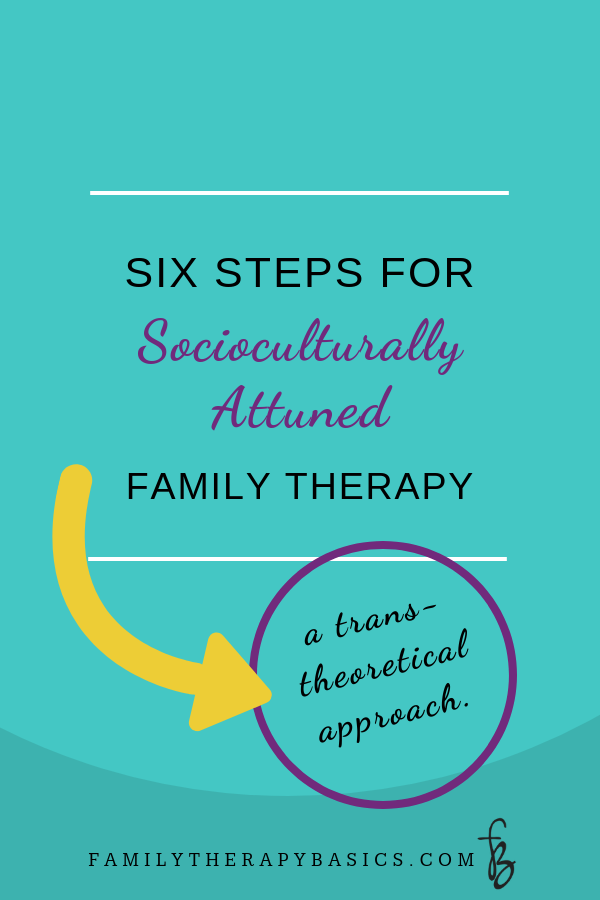Socio-cultural factors influence almost all significant relational interactions between clients and themselves, clients and their significant others, as well as clients and therapists. Language, economic status (and sense of mobility), ethnicity, gender, privilege, among other identities through which clients (and therapists) navigate their realities intersect in therapeutic interactions.
Failure to name and discuss these factors leaves clients to continue entrenched stories of self and relationships, and limits clients’ options for negotiating their needs and pursuing their sought-after changes.
In their recent article, From Knowing to Doing: Guidelines for Socioculturally Attuned Family Therapy, Knudson-Martin, McDowell, and Bermudez (2019) offer marriage and family therapists six guidelines for socioculturally attuned practice; I summarize them in this article.
Socioculturally Attuned Practice, Definition and Context
Socioculturally attuned practice is “practice that is aware and responsive to the intersections of societal context, culture, and power in client experience and positioned to promote equity” (p. 47).
According to the authors, “socioculturally attuned practice helps us expand our abilities to conceptualize and understand the impact of power dynamics and societal systems on what is presented in therapy” (p. 48), and this requires that therapists broaden their desired systems perspective from second order change to third order change.
Third Order Change
Based on cybernetic theory, first order change involves change in behavior. The change is not permanent; it serves a purpose, for a time. Second-order change involves change in the rules governing the system. It involves a new way of seeing, or understanding, and therefore leads to lasting change.
Both first and second-order change are defined and constrained by the system in which they occur. Third order change invites therapist to see the system within the system—the family within its sociocultural context—in order to make learning three (Bateson, 1972) possible. “Learning III is change in the process of learning . . . , e.g., a corrective change in the system of sets of alternatives from which choice is made” (p. 298).
Attunement
Socioculturally attuned practice (p. 48)
“recognizes inequitable social structures and resources.”
seeks “to apprehend each client’s unique confluence of social identities.”
is “aware that identities and power positions are fluid across time and place.”
is “influenced by historical legacies of injustice.”
Societal Context
Socioculturally attuned therapists conceptualize their work with each client by noticing, considering, and naming the larger context which clients have occupied. They view and apply their chosen theoretical model within the framework of the socio-cultural realities of clients. For example, from the article:
“An attachment‐based therapist might consider how sociocultural processes inhibit attachment or support safety and belonging in a particular person's life” (p. 49).
A solution-focused therapists may notice how societal contexts limit what solutions are viewed as possible and word questions in ways that help uncover the impact of oppressive sexist, racist, or classist social systems” (p. 49).
Power Analysis
Socioculturally attuned practice asks us to first name our identities—to notice the stories we carry about our own and others’ genders, relational roles, class, ethnicity, privilege, etc.—before we assess and address power with clients.
The authors remind us, “It is not enough to be sensitive to cultural differences; it is important to attend to how differences are valued and processes of privilege and oppression” (p. 50). The acknowledgment of our own relationship to power, and processes of privilege and oppression, create a new attunement with clients; we are able to approach our sociocultural practice with “a beginner’s mind” (i.e., assuming nothing).
The Six Guidelines of Socioculturally Attuned Therapy
1 | Attune to Context and Power
Be curious about the context and power dynamics in clients’ lives, recognizing that oftentimes these dynamics shift across contexts. For example, a female single mother may feel empowered at work, while also feeling defeated as a single mother.
Socioculturally attuned therapists, “tell their clients what they see and why they think it is important. They avoid using abstract concepts and often use questions to illuminate contextual issues in the details of client life” (p. 51)
2 | Name Injustice
Socioculturally attuned therapists, through affirming questioning, call forth experiences that are unjust. And, they name these events; perhaps renaming them within the understanding of injustice, and therefore initiating new relating between clients and these experiences.
“Naming injustice is validating. This is especially true when the injustice is ‘common;’ that is, violence and violation hidden and overlooked in the structure of daily life (p. 52).
3 | Value What Is Minimized
How do we value what is minimized? We are, along with many of our clients, taking part in a dominant culture which tells us what to value, what to minimize, and what to simply ignore. When our clients internalize the dominant culture in ways that stifle their self-views and expression, are we qualified to notice?
Maybe not. But, we are called, entrusted, even obligated to notice.
Thankfully, the authors specify:
Learning to recognize and value skills, ideas, and practices outside dominant culture norms requires self-reflexivity on the part of therapists. Self-reflexivity involves continuously raising our critical consciousness by taking a metaperspective of self-within-society—of the impact of our complex social locations and experience on our understanding and views of the world. (p. 53)
It begins, like the larger process of sociocultural practice, with awareness of our personal identities, histories, and perspectives—including our privilege. The privilege that keeps us from noticing injustices, because we are members of a dominant culture. (For some thoughts on privilege, see this recent article).
4 | Intervene In Power Dynamics
Feminist Family Therapy invites all therapists to address gender inequality and gender stereotypes inside the therapy room. Additionally, power is often a central issue in couple therapy as it relates to parenting, sexuality, division of labor, income, among other couple concerns (Murphy & Hecker, 2017). A therapist’s leadership is necessary in order for clients to be able to transform “power patterns” (p. 53).
The authors say, “Common across models is the willingness of socioculturally attuned therapists to be accountable for interventions that interrupt, rather than reinforce, societal power processes. . . . Also, supporting relational equity requires being intentional about how one’s interventions reinforce or disrupt societal power inequities” (p. 53).
We may not be aware of ways in which our therapeutic choices perpetuate, or mimic, power discrepancies between clients. For example, think through the following case:
Sam, a couple therapist, is working with a high conflict couple, Amy and Tony. For years, the couple’s dynamic has been that Amy yells when she is angry, and Tony gives in to her. Tony’s mother yelled, and he is very sensitive to volume. He has built up resentment toward Amy, because she makes “all the choices in the family,” including disciplining the kids, where they go on vacation, and how to spend and save money.
During the course of five sessions, Sam has told Tony to work on being more assertive, using an “I” position, stay present and respond when Amy yells, become more active with the children. Sam has told Amy to work on “not yelling.” Additionally, recently, Amy asked Tony to call Sam to cancel their weekly session, because she was upset with Tony. Tony calls Sam. Sam inquires into the cancellation, and before he hangs up, he asks Tony to call to confirm next week’s appointment.
Some questions for your reflection:
What are the power dynamics within this couple?
Describe the couple’s gender roles/relating. How is it similar or distinct from dominant cultural values?
How has Sam perpetuated or disrupted the couple’s power dynamics?
What questions would you ask Amy and Tony, in order to further understand power in their relationship?
5 | Envision Just Alternatives
“Socioculturally attuned therapists help clients envision alternatives to systems that marginalize them and perpetuate inequalities” (p. 54).
Once injustice has been named, and clients are more aware of their minimized stories and strengths, collaboratively lead clients toward different options for navigating larger systems. A therapist’s leadership is key. Research confirms that “therapists needed to introduce conversations regarding alternatives to stereotypic gender patterns for heterosexual couples to create just relationships based on equity” (p. 53 ).
It follows, then, that a therapist’s commitment to initiating socioculturally rich conversations would communicate to clients that therapy is a safe place to express their socio-cultural realities, and that the therapist is willing and qualified to empathically partner with them in developing more equitable relationships in a variety of systems.
6 | Transform to Make the Imagined A Reality
Beyond assisting clients in becoming aware of and addressing power and injustice, therapists affirm clients’ new actions and perspectives (their first and second-order change). They highlight progress within relationships, and help clients expand this progress to their participation in social networks.
“Therapists can help people build networks that support their ideals and devise strategies that resist dominant societal norms. . . . Therapists encourage clients to make conscious choices about how they respond to familial and societal injustices and the futures with which they align themselves” (p. 54).
DOWNLOAD YOUR SUMMARY GUIDE
For a cheat sheet of the six guidelines, along with references, register for the free resource library below, and check your inbox for login details.
Let’s Chat
Let me know in the comments below.
How do you currently address clients’ socio-cultural realities in therapy?











